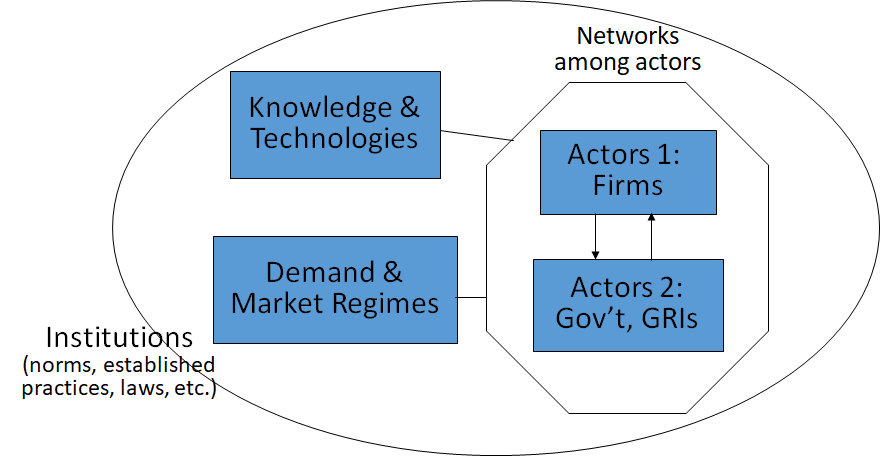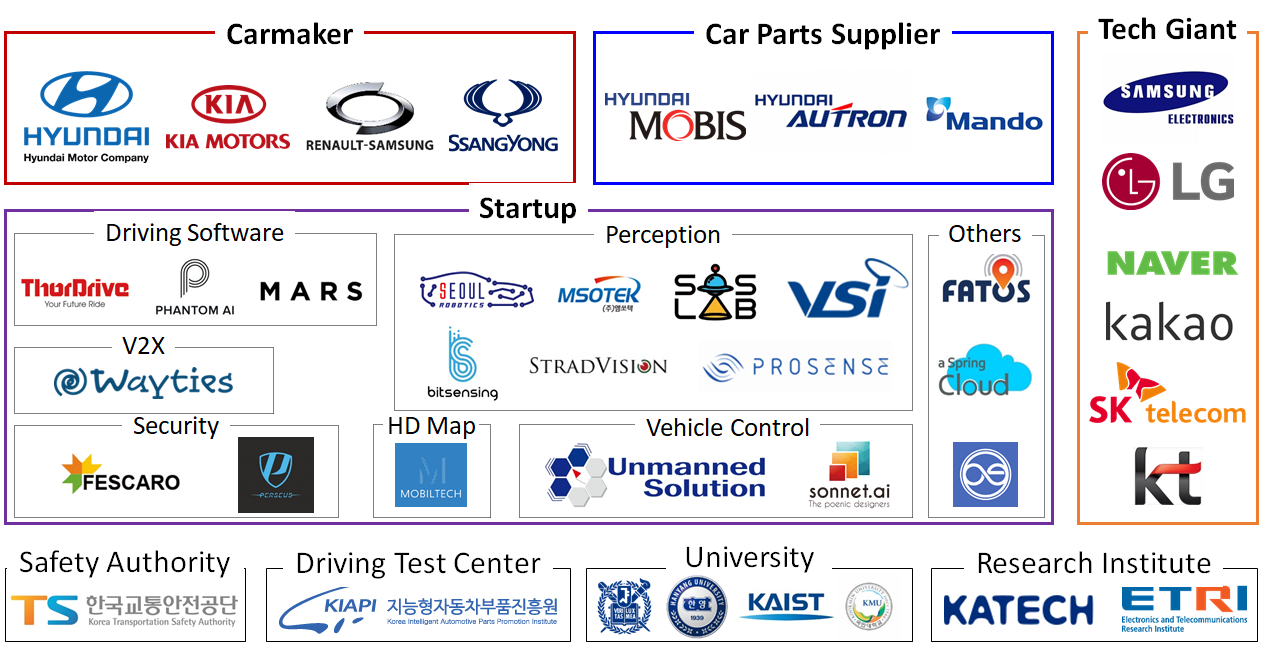Jeehoon KiDifferences in Public Policy on Autonomous Cars in France, Japan, and Korea:
|
| Policy Domain | France | Japan | Korea |
| Technology Roadmap Establishment | |||
| Deregulation and Revision/Enactment of Laws | |||
| R&D Investment | |||
| Building Infrastructure |
These findings will be used to appreciate the differences and similarities of public policy on ACs in France, Japan, and Korea. A comparative analysis is conducted first on the cases of France and Japan, which is expected to highlight the similarities and differences between Europe and Asia. The cases of Japan and Korea will then be compared, which is expected to highlight the similarities and differences between Asian countries.
Sectoral Systems of Innovation
The study employs the Sectoral Systems of Innovation (SSI) framework (Malerba 2004) to find out why each country implements their own public policies. The SSI is a lens with which to analyze the innovation process and the factors affecting innovation (Malerba 2004, i). The main building blocks of SSI are (a) knowledge and technologies, (b) actors (firm, government, etc.) and networks, (c) institutions (norms, practices, laws and so on), and (d) demand. In the SSI perspective, innovation process and sectoral transformation are the co-evolution of these four building blocks of the sector. The SSI and its building blocks are visualized in Figure 1.

The AC is an innovation in the automobile sector, and thus, SSI is a useful tool for analyzing the role of public policy in the socio-economic transformation process by ACs. The present study seeks out the reasons behind a country’s decision to implement certain public policies in the four building blocks of the SSI framework. For example, truck platooning R&D and its tests on public roads are more active in Europe than in Japan and Korea because trucking is a much bigger industry in Europe than in Japan and Korea. This factor is related to demand, which is the fourth building block of SSI. Korean public policy on automobiles is affected by Hyundai Motor Group because the company accounts for approximately 60% of the domestic market. This factor is related to the firm, which is the second building block of SSI.
Comparison of France and Japan
France and Japan are two of the most advanced countries, with some of the largest automobile manufacturers globally, including Renault, Toyota, Nissan, etc. By comparing France with Japan regarding public policy on ACs, this study attempts to find similarities based on their comparable socio-economic evolutionary level and their highly developed automobile industries. The differences are expected to be the result of the cultural, geographical contexts of France and Japan (Europe and Asia, respectively).
Comparison of Japan and Korea
Korea successfully caught up with developed countries such as Japan. As a country which was a developing country in Asia until relatively recently compared with France and Japan, Korea represents Asian developing countries, such as China and India, in some essential aspects of government policies, firm behaviors, and consumer preferences in the automobile sector. During its rapid economic growth process, Korea exhibited successful technological catch-up in various sectors including the automobile sector. The Korean government protected its domestic market, and Korean firms implemented suitable technological catch-up strategies including path-creating, stage-skipping, and path-following technological catch-up (Lee and Lim 2001). In the 1980s, Hyundai Motor Company opted to skip focusing on the development of the standard type of engine, the carburetor engine, and instead focused on developing fuel injection engines. This strategy was instrumental to the company becoming one of the major multinational automobile manufacturers. This success has also led many Asian developing countries to study and follow Korean public policies as well as the strategies employed by Korean firms.
Multinational automobile manufacturers have also been paying attention to the Korean market. Korean consumers prefer large sedans and luxury foreign cars because Koreans are conscious of how others view and evaluate them, and they consider their cars as symbols of their wealth. This preference could be extended to ACs because initial commercial ACs are expensive and attract considerable attention from the public. Consumers in China and India have very similar preferences, which is why Renault uses the Korean market as a test bed for their new large sedans via its subsidiary Renault Samsung Motors.
This study attempts to find the interactions between Korean public policy and the behaviors of firms and consumers in the emerging AC era, which is a good starting point to understand and anticipate the socio-economic transformation of Korea and that of Asian developing countries. Multinational carmakers can utilize these insights in establishing their business strategies for the huge Asian market.
Autonomous Car Industry in Korea
Korea is the 6th largest auto manufacturing country worldwide, producing more than 4 million vehicles in 2017. In Korea, various actors prepare for the coming self-driving car era, including carmakers, car parts suppliers, tech giants, startups, etc. Figure 2 presents a breakdown of the Korean self-driving sector by actor type.

Among the carmakers which have plants in Korea, Hyundai Motor Company demonstrated Leve2l 4 automated driving on a 190 km highway road trip in February 2018. Kia Motors develops 5G-based vehicle communication networks (5G V2X) with SK Telecom, Korea’s largest wireless carrier. Korean car parts suppliers Hyundai Mobis and Mando focus on developing sensors for autonomous vehicles. In August 2018, Hyundai Mobis invested about 6 million euros in a Korean startup StradVision for deep learning cameras. This is the largest investment in Hyundai Mobis’ history except investments in its subsidiary companies. Meanwhile, tech giant Samsung Electronics acquired a U.S. car infotainment and audio company Harman for 8 billion US dollars in 2017. LG Electronics is actively partnering with various companies for its automated and connected car business, including global digital mapping company HERE Technologies, automotive semiconductor manufacturer NXP, German advanced driver assistance systems (ADAS) developer HELLA Aglaia, and chipmaker Qualcomm.
The Korean government is implementing various policies that facilitate self-driving technology development and commercialization. The government has three targets:
- By 2020, the commercialization of Level 3 self-driving cars
- By 2022, the construction of infrastructure for full automation (e.g., cooperative intelligent transportation system (C-ITS), high-definition (HD) maps)
- By 2030, the commercialization of full automation
To achieve these goals, the Ministry of Trade, Industry and Energy (MOTIE) charted a technology and services roadmap in December 2017. The roadmap is divided into three parts: elements technology (e.g., multi-band radar, low-cost LiDAR), autonomous driving algorithms (e.g., highway driving assist (HDA), lane change assist (LCA)), and autonomous driving service such as robo-taxi, autonomous electric shuttle. Meanwhile, the Ministry of Land, Infrastructure and Transport (MOLIT) unveiled a policy roadmap in February 2018. MOLIT’s policy roadmap consists of four segments: R&D facilities, infrastructure, public relations, laws & regulations. Step-by-step goals in each segment are presented in Figure 3.

References
Chun, H. W. & S. J. Koe (2015). Policy Trends in Autonomous Vehicle. Electronics and Telecommunications Trends, 30, 129-137. (in Korean)Fagnant, D. J. & K. Kockelman (2015). Preparing a nation for autonomous vehicles: opportunities, barriers and policy recommendations. Transportation Research Part A: Policy and Practice, 77, 167-181.
Joint ministerial working group. (2018). Future Automotive Industry Development Strategy (mi-lae-cha san-eob bal-jeon jeon-lyag) (in Korean)
http://www.motie.go.kr/motie/ne/presse/press2/bbs/bbsView.do?bbs_seq_n=160144&bbs_cd_n=81 (Accessed 21 October 2018)
Korea Institute for Advancement of Technology (KIAT). (2017). Autonomous vehicle technology and policy trends in Europe (yu-leob-ui ja-yul-ju-haeng-ja-dong-cha gi-sul mich jeong-chaeg dong-hyang). (in Korean)
(Accessed 29 July, 2018).
Lee, K. & C. Lim (2001). Technological regimes, catching-up and leapfrogging: findings from the Korean industries. Research Policy, 30, 459-483.
Malerba, F. (2004). Sectoral systems of innovation: concepts, issues and analyses of six major sectors in Europe. New York, N.Y.: Cambridge University Press.
Milakis, D., B. van Arem & B. van Wee (2017). Policy and society related implications of automated driving: A review of literature and directions for future research. Journal of Intelligent Transportation Systems, 21, 324-348.
Ministry of Land, Infrastructure and Transport. (2018). Smart Traffic System Development Plan for Commercialization of Autonomous Driving (ja-yul-ju-haeng sang-yong-hwa-leul wi-han seu-ma-teu-gyo-tong-si-seu-tem gu-chug-bang-an). (in Korean)
http://www.motie.go.kr/motie/ne/presse/press2/bbs/bbsView.do?bbs_seq_n=160144&bbs_cd_n=81 (Accessed 21 October 2018)
Nurun, (2013). From the Smartphone to the Smartcar. https://www.nurun.com/en/ (Accessed 29 July, 2018)







